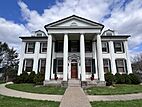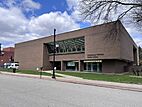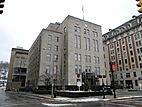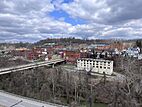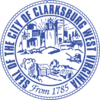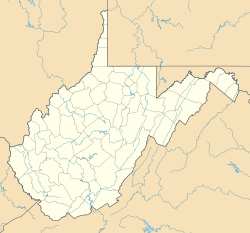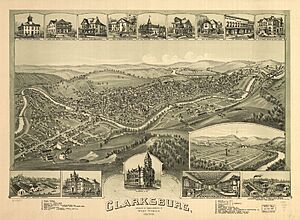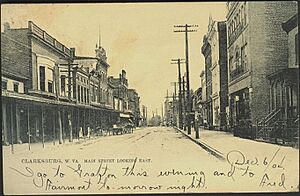Clarksburg, West Virginia facts for kids
Quick facts for kids
Clarksburg, West Virginia
|
|||
|---|---|---|---|
|
Downtown Clarksburg
Clarksburg-Harrison Public Library
Harrison County Courthouse
Glen Elk Historic District
|
|||
|
|||
| Nickname(s):
Jewel of the Hills
|
|||
| Motto(s):
"Proud Past...Unlimited Future"
|
|||

Location of Clarksburg in Harrison County, West Virginia
|
|||
| Country | United States | ||
| State | West Virginia | ||
| County | Harrison | ||
| Established | 1785 | ||
| Area | |||
| • City | 9.71 sq mi (25.16 km2) | ||
| • Land | 9.71 sq mi (25.16 km2) | ||
| • Water | 0.00 sq mi (0.00 km2) | ||
| Elevation | 994 ft (303 m) | ||
| Population
(2020)
|
|||
| • City | 16,039 | ||
| • Estimate
(2021)
|
15,784 | ||
| • Density | 1,567.49/sq mi (605.20/km2) | ||
| • Metro | 68,761 | ||
| Time zone | UTC-5 (EST) | ||
| • Summer (DST) | UTC-4 (EDT) | ||
| ZIP Codes |
26301-26302, 26306
|
||
| Area code | 304 | ||
| FIPS code | 54-15628 | ||
| GNIS feature ID | 1537358 | ||
| Website | Clarksburg, West Virginia | ||
Clarksburg is a city in West Virginia, United States. It's the main city of Harrison County, located in the north-central part of the state. In 2020, about 16,039 people lived there. This made it the tenth largest city in West Virginia. It's also the main city for the larger Clarksburg area, which had about 90,434 people in 2020. Clarksburg was even named the National Small City of the Year in 2011!
Contents
Clarksburg's History
People have lived in the Clarksburg area for thousands of years. The Hopewell culture built the Oak Mounds outside the city between 1 and 1000 AD. The first European visitor was John Simpson, a trapper, in 1764. He set up his camp on the West Fork River.
Early Settlement and Growth

Settlers started claiming land and building cabins around 1772. Major Daniel Davisson claimed 400 acres in 1773. This is where most of the city stands today.
The town of Clarksburg was officially started in 1785. It was named after General George Rogers Clark. He was a Virginian who led many trips against the British and Native Americans. He was important during the American Revolution.
In 1786, a road was planned from Winchester, Virginia to Morgantown. A branch of this road would go through Clarksburg. In 1787, the Randolph Academy opened in Clarksburg. It was the first private school west of the Allegheny Mountains.
The first courthouse for Harrison County was built in Clarksburg in 1787. Over time, four bigger courthouses were built. The newest one was finished in 1932.
Travel was slow, which made it hard for the area to grow. So, people helped build the Northwestern Turnpike, a toll road. This road helped Clarksburg grow in the 1830s. The Baltimore and Ohio Railroad reached Clarksburg in 1856. This brought even more growth.
Two historic buildings from this time are still around. The Stealey-Goff-Vance House was built in 1807. Waldomore was built in 1839. It was the Clarksburg Public Library for many years.
Clarksburg During the Civil War
During the American Civil War, people in Clarksburg had different opinions. Some supported the Union, and some supported the Confederacy. John S. Carlile from Harrison County helped create the Restored Government of Virginia. This led to the creation of West Virginia.
Clarksburg was an important supply base for the Union army. This was because of the B&O railroad. At one point, over 7,000 Union troops were in the city. Confederate raiders tried to attack Clarksburg, but they never reached the city itself. The war helped Clarksburg's economy. Many new businesses opened to serve the soldiers.
Growth After the War
In 1877, Clarksburg was one of three cities that could become the new state capital. It came in second, and Charleston, West Virginia became the capital.
Around this time, Clarksburg started to get more factories. These included glass and coal industries. The city grew slowly but steadily. Telephone service began in the mid-1880s. Downtown streets got electricity in 1889.
Clarksburg really started to boom around 1900. Coal and glass production grew a lot. The population jumped from 4,050 in 1900 to 27,869 in 1920. This was partly because nearby towns joined Clarksburg.
Many buildings in the Clarksburg Downtown Historic District were built during this time. The first sewer lines were installed in 1900. The city's first trolley opened in 1901. Important buildings like the Empire National Bank (1907) and the Goff Building (1911) were constructed.
Cars also helped the city grow. U.S. Route 50 was paved through Clarksburg in 1928. Later, Interstate 79 opened in 1979. This connected Clarksburg to Charleston and Pennsylvania.
During the Great Depression, some banks and businesses closed. Clarksburg's population went down. However, the city kept many of its beautiful old buildings. Today, it is West Virginia's tenth largest city.
Federal Bureau of Investigation
In 1995, the Federal Bureau of Investigation (FBI) opened its Criminal Justice Information Services Division complex in Clarksburg. This big center holds many of the FBI's law enforcement records. Senator Robert C. Byrd worked hard to bring this important project to West Virginia.
Clarksburg's Geography
Clarksburg is located where the West Fork River and Elk Creek meet. The city covers about 9.74 square miles (25.2 square kilometers) of land. Clarksburg is in the North-Central region of West Virginia. It sits at an elevation of 1,007 feet (307 meters).
It is at the meeting point of U.S. 50 and U.S. 19. It is also close to Interstate 79.
Climate in Clarksburg
Clarksburg has a humid subtropical climate. This means it has warm, humid summers and mild winters. Sometimes, cold air from Canada can affect the weather.
- The average yearly temperature is about 54.9°F (12.7°C).
- The highest temperature ever recorded was 102°F (39°C).
- The lowest temperature ever recorded was -24°F (-31°C).
- Clarksburg gets about 44.84 inches (1139 mm) of rain each year.
- It also gets about 25 inches (64 cm) of snow each year.
| Climate data for Clarksburg Benedum Airport, West Virginia (1991–2020 normals, extremes 1922–present) | |||||||||||||
|---|---|---|---|---|---|---|---|---|---|---|---|---|---|
| Month | Jan | Feb | Mar | Apr | May | Jun | Jul | Aug | Sep | Oct | Nov | Dec | Year |
| Record high °F (°C) | 78 (26) |
79 (26) |
88 (31) |
95 (35) |
96 (36) |
100 (38) |
102 (39) |
101 (38) |
102 (39) |
95 (35) |
85 (29) |
78 (26) |
102 (39) |
| Mean maximum °F (°C) | 65.2 (18.4) |
66.8 (19.3) |
76.1 (24.5) |
84.0 (28.9) |
87.8 (31.0) |
90.6 (32.6) |
91.8 (33.2) |
90.9 (32.7) |
88.9 (31.6) |
82.0 (27.8) |
74.7 (23.7) |
67.0 (19.4) |
92.7 (33.7) |
| Mean daily maximum °F (°C) | 42.6 (5.9) |
45.6 (7.6) |
54.7 (12.6) |
67.6 (19.8) |
75.7 (24.3) |
82.5 (28.1) |
85.5 (29.7) |
84.6 (29.2) |
78.9 (26.1) |
67.6 (19.8) |
56.0 (13.3) |
46.6 (8.1) |
65.7 (18.7) |
| Daily mean °F (°C) | 33.6 (0.9) |
36.1 (2.3) |
44.1 (6.7) |
55.3 (12.9) |
63.9 (17.7) |
71.3 (21.8) |
74.8 (23.8) |
73.6 (23.1) |
67.2 (19.6) |
55.8 (13.2) |
45.7 (7.6) |
37.8 (3.2) |
54.9 (12.7) |
| Mean daily minimum °F (°C) | 24.6 (−4.1) |
26.6 (−3.0) |
33.4 (0.8) |
43.1 (6.2) |
52.0 (11.1) |
60.2 (15.7) |
64.2 (17.9) |
62.7 (17.1) |
55.4 (13.0) |
44.1 (6.7) |
35.5 (1.9) |
29.0 (−1.7) |
44.2 (6.8) |
| Mean minimum °F (°C) | 1.3 (−17.1) |
6.2 (−14.3) |
13.4 (−10.3) |
25.8 (−3.4) |
34.8 (1.6) |
45.6 (7.6) |
52.7 (11.5) |
51.0 (10.6) |
40.8 (4.9) |
28.5 (−1.9) |
18.9 (−7.3) |
10.5 (−11.9) |
−1.6 (−18.7) |
| Record low °F (°C) | −24 (−31) |
−23 (−31) |
−18 (−28) |
7 (−14) |
23 (−5) |
33 (1) |
41 (5) |
39 (4) |
29 (−2) |
14 (−10) |
−2 (−19) |
−13 (−25) |
−24 (−31) |
| Average precipitation inches (mm) | 3.30 (84) |
3.14 (80) |
3.62 (92) |
3.89 (99) |
4.25 (108) |
4.54 (115) |
5.40 (137) |
3.62 (92) |
3.51 (89) |
3.02 (77) |
3.17 (81) |
3.38 (86) |
44.84 (1,139) |
| Average precipitation days (≥ 0.01 in) | 15.1 | 13.5 | 14.1 | 14.6 | 15.8 | 14.2 | 14.9 | 13.9 | 13.3 | 13.6 | 11.1 | 14.3 | 168.4 |
| Source: NOAA | |||||||||||||
| Climate data for Clarksburg 1 (near city center), West Virginia (1991–2020 normals, extremes 1922–present) | |||||||||||||
|---|---|---|---|---|---|---|---|---|---|---|---|---|---|
| Month | Jan | Feb | Mar | Apr | May | Jun | Jul | Aug | Sep | Oct | Nov | Dec | Year |
| Record high °F (°C) | 78 (26) |
79 (26) |
88 (31) |
95 (35) |
96 (36) |
100 (38) |
102 (39) |
101 (38) |
102 (39) |
94 (34) |
85 (29) |
78 (26) |
102 (39) |
| Mean maximum °F (°C) | 65.2 (18.4) |
66.8 (19.3) |
76.1 (24.5) |
84.0 (28.9) |
87.8 (31.0) |
90.6 (32.6) |
91.8 (33.2) |
90.9 (32.7) |
88.9 (31.6) |
82.0 (27.8) |
74.7 (23.7) |
67.0 (19.4) |
92.7 (33.7) |
| Mean daily maximum °F (°C) | 39.7 (4.3) |
43.2 (6.2) |
52.2 (11.2) |
65.4 (18.6) |
74.7 (23.7) |
82.1 (27.8) |
85.1 (29.5) |
83.6 (28.7) |
77.4 (25.2) |
65.6 (18.7) |
53.4 (11.9) |
44.0 (6.7) |
63.9 (17.7) |
| Daily mean °F (°C) | 30.7 (−0.7) |
33.3 (0.7) |
41.0 (5.0) |
52.3 (11.3) |
62.2 (16.8) |
70.3 (21.3) |
74.0 (23.3) |
72.6 (22.6) |
65.9 (18.8) |
53.9 (12.2) |
42.6 (5.9) |
35.3 (1.8) |
52.8 (11.6) |
| Mean daily minimum °F (°C) | 21.7 (−5.7) |
23.4 (−4.8) |
29.7 (−1.3) |
39.1 (3.9) |
49.6 (9.8) |
58.5 (14.7) |
63.0 (17.2) |
61.7 (16.5) |
54.5 (12.5) |
42.1 (5.6) |
31.9 (−0.1) |
26.6 (−3.0) |
41.8 (5.4) |
| Mean minimum °F (°C) | 1.3 (−17.1) |
6.2 (−14.3) |
13.4 (−10.3) |
25.8 (−3.4) |
34.8 (1.6) |
45.6 (7.6) |
52.7 (11.5) |
51.0 (10.6) |
40.8 (4.9) |
28.5 (−1.9) |
18.9 (−7.3) |
10.5 (−11.9) |
−1.6 (−18.7) |
| Record low °F (°C) | −24 (−31) |
−23 (−31) |
−18 (−28) |
7 (−14) |
23 (−5) |
33 (1) |
41 (5) |
39 (4) |
29 (−2) |
14 (−10) |
−2 (−19) |
−13 (−25) |
−24 (−31) |
| Average precipitation inches (mm) | 3.54 (90) |
3.39 (86) |
4.17 (106) |
4.08 (104) |
4.78 (121) |
4.85 (123) |
5.33 (135) |
3.96 (101) |
3.67 (93) |
3.34 (85) |
3.32 (84) |
3.81 (97) |
48.24 (1,225) |
| Average snowfall inches (cm) | 7.9 (20) |
7.8 (20) |
3.5 (8.9) |
0.1 (0.25) |
0.0 (0.0) |
0.0 (0.0) |
0.0 (0.0) |
0.0 (0.0) |
0.0 (0.0) |
0.0 (0.0) |
0.7 (1.8) |
3.8 (9.7) |
23.8 (60) |
| Average precipitation days (≥ 0.01 in) | 15.6 | 13.9 | 14.2 | 14.2 | 15.0 | 12.7 | 12.4 | 10.9 | 10.1 | 11.6 | 12.3 | 15.3 | 158.2 |
| Average snowy days (≥ 0.1 in) | 4.9 | 4.2 | 1.6 | 0.1 | 0.0 | 0.0 | 0.0 | 0.0 | 0.0 | 0.0 | 0.7 | 3.1 | 14.6 |
| Source: NOAA | |||||||||||||
Nearby Cities and Towns
 |
New Martinsville | Shinnston | Fairmont, Morgantown |  |
| Parkersburg | Bridgeport | |||
| Glenville, Charleston | Weston | Philippi |
Clarksburg's Population
| Historical population | |||
|---|---|---|---|
| Census | Pop. | %± | |
| 1860 | 895 | — | |
| 1880 | 2,307 | — | |
| 1890 | 3,008 | 30.4% | |
| 1900 | 4,050 | 34.6% | |
| 1910 | 9,201 | 127.2% | |
| 1920 | 27,869 | 202.9% | |
| 1930 | 28,866 | 3.6% | |
| 1940 | 30,579 | 5.9% | |
| 1950 | 32,014 | 4.7% | |
| 1960 | 28,112 | −12.2% | |
| 1970 | 24,864 | −11.6% | |
| 1980 | 22,371 | −10.0% | |
| 1990 | 18,059 | −19.3% | |
| 2000 | 16,743 | −7.3% | |
| 2010 | 16,578 | −1.0% | |
| 2020 | 16,039 | −3.3% | |
| 2021 (est.) | 15,784 | −4.8% | |
| U.S. Decennial Census | |||
2020 Census Data
In 2020, Clarksburg had 16,061 people and 6,588 households.
- About 88% of the people were White.
- About 3.9% were African American.
- About 0.9% were from other races.
- About 6.4% were from two or more races.
- About 3% of the population was Hispanic or Latino.
The average age in the city was 39.7 years old.
Belgian Community in Clarksburg
In the early 1900s, many French-speaking Belgians moved to Clarksburg. They came because of the window-glass industry. Belgium's glass factories were having problems. West Virginia had cheap natural gas and lots of sand, which are good for making glass.
These Belgian workers were very skilled. They helped West Virginia become a big center for glass production. They also formed strong communities. They had their own social clubs, music groups, and celebrations. Some even elected Socialist mayors.
Over time, new machines replaced many skilled glassworkers. But the history and culture of the Belgian-Americans are still celebrated today.
Clarksburg's Economy
Clarksburg had many natural resources and good railroad access. This attracted different industries. These included chemical plants, brickworks, and glass factories. The Akro-Agate marble company was one famous glass factory.
Many immigrants came to Clarksburg for work. These included people from Ireland, Italy, Greece, France, Belgium, and Spain.
In the early 1900s, Clarksburg had:
- Eight banks
- Three hospitals
- Several nice hotels, like the Waldo Hotel
By 1929, Clarksburg's population reached its highest point. During the Great Depression, the city lost some industries and people. But during World War II, the railroad made it an important center again.
New highways like Interstate 79 in the 1970s helped the city. But some factories closed in the 1980s. In the 1990s, new growth came from government and technology jobs. The FBI's Criminal Justice Information Services Center moved to Clarksburg.
- In 1975, Clarksburg opened a new public library. It was designed by Marcel Breuer.
- The city has a daily newspaper, The Exponent-Telegram.
- Eastpointe and Newpointe are the largest strip malls in West Virginia. Most of Clarksburg's stores are now in these malls.
Akro Agate Company
The Akro Agate Company in Clarksburg was a world leader in making glass marbles. The company moved to Clarksburg in 1914. This was because of the good glass sand and cheap natural gas.
During the 1930s and 1940s, the popularity of Chinese checkers made marbles very profitable. They made over 2,000,000 marbles each week! The company also made glass vases and colorful containers. They even made tiny glass dishes for children's toys. Today, collectors look for these marbles and glass items. The company closed in 1951.
Hazel-Atlas Glass Company
Hazel-Atlas Glass Company was a huge glassmaking company. It was the largest in the United States from the 1930s to the 1950s. They made many inexpensive glass items, like "depression glass" table sets. They also made millions of glass items given away in food products.
Hazel Atlas had a large factory in Clarksburg. It was the world's biggest tumbler factory. By 1920, this factory had 15 acres of space and employed 1,200 people. It shipped products all over the world. The factory closed in 1987.
Rolland Glass Company
The Rolland Glass Plant was a glass company started in 1921. It made high-quality tableware and stemware. The company was a big employer in Clarksburg. At its busiest, it had over 1,000 workers.
The company faced problems in the late 1960s. It closed permanently in 1985. Today, the site of the plant is home to the Rolland Glass Museum. The museum shares the history of the company and glassmaking in Clarksburg.
Other Glass Companies
- Clarksburg Glass Company (1893–1921)
- National Bottle Company (1903–1919)
- Diamond Glass Company (1920–1930s)
- West Virginia Glass Specialty Company (1940s–1950s)
Clarksburg's Culture
Clarksburg is a center for culture in north-central West Virginia. It hosts many fun events and festivals.
- Since 1979, Clarksburg has hosted the annual West Virginia Italian Heritage Festival. This happens during Labor Day weekend.
- Every September since 1991, the city has hosted the West Virginia Black Heritage Festival.
- Since 2006, Clarksburg has hosted the annual Glen Elk Wine, Music and Arts festival.
- Since 1997, Clarksburg has also hosted the Greater Clarksburg 10K race. This is the official WV 10K State Championship.
Fun Places to Visit
- Clarksburg Amphitheater
- Clarksburg City Park at Norwood
- Clarksburg History Museum
- Clarksburg Splash Zone
- Robinson Grand Performing Arts Center
- Waldo Hotel
- Waldomore
Transportation in Clarksburg
Clarksburg is located at the meeting point of U.S. Route 50 and Interstate 79. These are important roads for the city. Other major highways include West Virginia Route 20, West Virginia Route 58, U.S. Route 19, and West Virginia Route 98.
The Northwestern Turnpike (now U.S. Route 50) reached Clarksburg in 1836. The Baltimore and Ohio Railroad arrived in 1856.
 Interstate 79
Interstate 79 U.S. Route 50
U.S. Route 50 U.S. Route 19
U.S. Route 19 West Virginia Route 20
West Virginia Route 20 West Virginia Route 58
West Virginia Route 58 West Virginia Route 98
West Virginia Route 98 West Virginia Route 279
West Virginia Route 279
Clarksburg is served by the North Central West Virginia Airport. It is about 7 miles (11 km) east of the city.
Famous People from Clarksburg
- Tony Anthony: actor and director
- Hugh Aynesworth: author and journalist
- Babe Barna: Major League Baseball Player
- Rex Bumgardner: professional football player
- John S. Carlile: politician, helped found West Virginia
- Phyllis Curtin: opera singer
- John W. Davis: ran for President in 1924
- Jimbo Fisher: college football coach
- Nathan Goff Jr.: congressman
- Howard Mason Gore: United States Secretary of Agriculture
- Thomas "Stonewall" Jackson: famous Confederate General
- John David Jamerson: NBA basketball player
- Louis A. Johnson: United States Secretary of Defense
- Pare Lorentz: film director
- Peter Marshall: host of Hollywood Squares
- Melville Davisson Post: author
- Jay Randolph: sportscaster
- Cyrus Vance: United States Secretary of State
- Patty Weaver: actress
See also
 In Spanish: Clarksburg (Virginia Occidental) para niños
In Spanish: Clarksburg (Virginia Occidental) para niños



